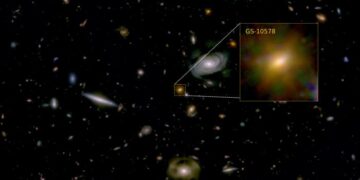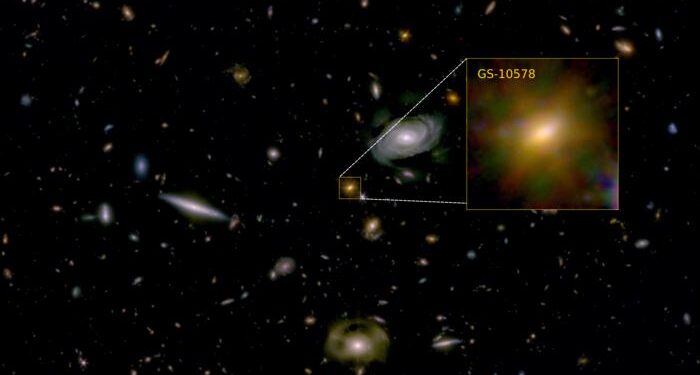At the core of nearly every large galaxy, including our own Milky Way, lies a supermassive black hole—an entity with a mass millions to billions of times greater than that of our sun. This challenges our previous understanding and invites us to reconsider how galaxies live and die. What other secrets might these black holes be hiding about the evolution of the universe? Let’s unravel the mysteries of the cosmos one discovery at a time.
A Unique Opportunity for Astronomical Observations
The James Webb Space Telescope’s observations of Pablo’s Galaxy have allowed astronomers to witness the intricate dynamics at play in a galaxy that formed around 200 billion solar masses of stars between 12.5 and 11.5 billion years ago. Despite this massive star formation, the galaxy now shows signs of quiescence—a state in which new stars are no longer being formed. For astronomers, this situation presents a unique opportunity to study the precise mechanisms through which supermassive black holes can influence the life cycle of their host galaxies.
The key to understanding the role of supermassive black holes in quenching star formation lies in the process of gas expulsion. Using the powerful capabilities of the JWST, astronomers have detected that Pablo’s Galaxy is ejecting vast amounts of gas at incredibly high velocities—around 1,000 kilometers per second. This gas, essential for star formation, is expelled with such force that it escapes the galaxy’s gravitational pull, effectively depriving the galaxy of the raw materials needed to create new stars.
Revealing the Science Behind the Phenomenon
One of the most fascinating aspects of this discovery is the nature of the expelled gas. Unlike in previous observations of other galaxies with accreting black holes, the gas in Pablo’s Galaxy is primarily colder and denser, making it difficult to detect using traditional telescopes. However, thanks to the JWST’s superior sensitivity, astronomers can now observe this dark gas because it blocks some of the light from the galaxy behind it. This phenomenon provides direct evidence of a ‘starving’ component that prevents the galaxy from sustaining star formation.
The significance of this observation cannot be understated. For decades, astrophysicists have theorized that supermassive black holes could exert substantial control over the evolutionary processes of galaxies. Still, the evidence has always been indirect or circumstantial. Now, with the JWST’s observations, scientists can see these processes in action, offering a new and compelling narrative for understanding how galaxies evolve and eventually die.
Broader Implications for Our Understanding of the Universe
The discovery that supermassive black holes can “starve” their host galaxies carries profound implications for cosmology and our understanding of the universe’s evolution. The process observed in Pablo’s Galaxy is not just a rare occurrence but may represent a common phenomenon in the cosmos. By observing these interactions at such a detailed level, astronomers can now begin to draw broader conclusions about how galaxies form, evolve, and cease to exist.
These findings also open up new questions about the relationship between black holes and their host galaxies. If supermassive black holes are capable of halting star formation by expelling gas, what other effects might they have? Could they also influence the shape and structure of galaxies or even the distribution of dark matter within them? The answers to these questions could significantly shift our understanding of galactic dynamics and the fundamental forces that shape the universe.
While the JWST has provided groundbreaking observations, the journey to fully understand the relationship between supermassive black holes and galaxy formation is far from complete. Future observations with instruments like the Atacama Large Millimeter/Submillimeter Array (ALMA) are planned to target the coldest, darkest components of the galaxy’s gas clouds. These observations will help researchers further understand how supermassive black holes affect their surrounding regions and whether any hidden reserves of star-forming material might still exist within the galaxy.
Such detailed observations are essential for refining our theoretical models of galaxy formation and evolution. They will also provide insights into whether the quiescent state observed in Pablo’s Galaxy is permanent or temporary and what factors might lead a galaxy to “reignite” and begin forming stars once again.
Connecting Cosmic Dots: From Observations to Theories
One of the most compelling aspects of the JWST’s discovery is how it connects theoretical predictions with real-world observations. For years, astronomers have speculated about the impact of black holes on their host galaxies, but these ideas have often been based on computer models or indirect evidence. Now, with JWST’s observations, these theories are being validated or challenged in ways that were previously impossible. This bridging of the gap between theory and observation not only enriches our understanding of cosmic phenomena but also underscores the importance of advanced astronomical tools like JWST in probing the universe’s most fundamental processes.
Reflecting on the Evolution of Astronomical Tools and Techniques
The ability of the James Webb Space Telescope to observe these high-velocity gas expulsions and other intricate cosmic processes marks a significant leap forward in the field of astronomy. Before Webb, our understanding of the role of black holes in galactic evolution was largely theoretical, based on models that predicted the dramatic effects these massive entities could have on their surroundings. With the direct evidence provided by Webb, these models can now be refined, providing a more nuanced picture of the interplay between black holes and galaxies.
The JWST’s discovery also serves as a reminder of the importance of continued investment in space exploration and astronomy. Each new telescope, probe, or instrument we develop allows us to peel back another layer of the cosmic onion, revealing more about the universe’s complexities and the forces that shape it. As we push the boundaries of our knowledge, we also push the boundaries of what is possible, both in terms of technology and human understanding.
Conclusion: A New Era of Cosmic Discovery and Inquiry
The revelations from the James Webb Space Telescope about Pablo’s Galaxy and its supermassive black hole represent a new era in our exploration of the cosmos. They remind us that the universe is not a static place but a dynamic, evolving entity where even the most massive and seemingly unchangeable structures, like galaxies, are constantly being shaped and reshaped by the forces at play within them. Each discovery not only answers old questions but also raises new ones, inviting us to look deeper, think harder, and wonder more profoundly about the mysteries of the universe.
As we continue to gaze into the vastness of space, each observation adds a new thread to the ever-expanding narrative of the cosmos. The journey to understand the universe is far from over; in fact, it may just be beginning. And with tools like the James Webb Space Telescope, we are more equipped than ever to explore that journey, one discovery at a time.
Reference:
D’Eugenio, F., Maiolino, R., Carniani, S., Llerena, M., Iani, E., Mannucci, F., Marconi, A., Puglisi, A., & Wylezalek, D. (2024). A fast-rotator post-starburst galaxy quenched by supermassive black-hole feedback at z=3. Nature Astronomy.



















